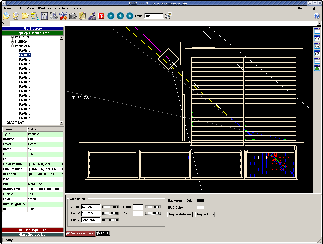Response of the GLAST-LAT Calibration Unit to sources of background
In preparation for the GLAST Symposium Link to current DRAFT : BackgroundPoster_FINAL
Abstract
The main sources of background for the operation of the GLAST-Large Area Telescope are primary protons, albedo gammas from the earth and photons coming from interaction of positron and protons in the micro-meteoride-shield (MMS) surrounding the LAT, which create photon pairs through annihilation and pi0 decay.
An extensive beam test campaign was performed in summer 2006 on the LAT Calibration Unit (CU), a detector built with flight spare parts of the LAT; the goal of the program was to support the LAT Instrument Calibration by providing direct measurements of the physical processes taking place in the CU detector when exposed to different beams, by comparing the obtained measurements with Monte Carlo predictions and by eventually validating the full LAT MC code used to provide instrument calibrations and background rejection strategies.
The study of the signal produced in the CU by sources of the LAT background was performed with photon beams shot from the side of the CU, proton beams and positrons beams reaching the CU after crossing an MMS target.
Results from analysis of these data are presented in this talk.
Responsible persons : Johan Bregeon, Carmelo Sgrò
People interested (Please Add your name here if you want to contribute)
- Johan Bregeon : hadronic interactions, albde gamma
- Carmelo Sgrò : positron annihilation
- Francesco Longo : hadronic process in GEANT4
Preliminary Content (feel free to modify/comment it !) :
Introduction :
- Short summary of what background means for GLAST - reference to another poster ?
- General Beamtest setup to study the CU response to background sources
Main Tabs : Study of the different background sources
- benchmark of hadronic process in GEANT4 with proton/pions at PS and SPS
- hadronic interactions in MMS (PS proton runs)
- positron annihilation events in MMS (PS positron and electons)
- gamma-ray albedo (PS special fullbrehm runs)
Conclusion :
- What we have learned thanks to the beamtest
- How to tune GlastRelease to reproduce better these special classes of events
Material for the poster
- Simulated positron annihilation in the MMS (from BT-1356, event 4040)
Usefull links to presentations and confluence pages
Positrons
- Status Report 15 august 2006 : Luca
vrvs_15_aug.pdf - August 18, 2006 : Philippe
cernps_20060818.pdf - September 12th, 2006 : Mizuno
QuickLookPositronElectron_2006-09-12.ppt - October 11th, 2006 : Gary
PositronAnnihilations_8-30-2006.pdf - January 17th, 2007 : Emanuele
2007_01_17_MMS_Report_Bonamente.pdf
Proton Background :
- Workshop 3 : Bruel
pisa_dc2_20060629.pdf
- Workshop 3 : Alex
Blanket_background_III.pdf - November 8th, 2006 : Alex
MMS_Alex_110206.pdf
Hadronic processes in mms :
- Confluence page by Alex :
Hadronic Processes in the MMS
Hadronic models / protons :
- October 18th, 2006 : Johan
HC_13Oct2006.pdf
GEOMETRY
- Confluence page :
Geometry on Confluence - MMS Position :
MMS_pos.pdf- heprep file : cu06mmsPositron
cu06mmsPositron.heprep.gz - heprep file : cu06mmsProton
cu06mmsProton.heprep.gz
- heprep file : cu06mmsPositron
- Calibration Unit Dimensions, August 1st, 2006 :
Dimensions_CU.ppt
ACD
- Workshop 4 : ACD Backsplash Studies (Luis)
workshop4_luis.pdf
Background
- Workshop 2, Reminder of Background components : Atwood
ResidualBackgrounds.ppt - Bill's DC2 closeout slides pdf ppt
- C&A Background page confluence :
Background Rejection and Aeff - Irredicible Background
Tagging Irredicible Backgrounds - Final version of Backgroun flux review by C&A group
LATBackgroundReviewcompressed.pdf
